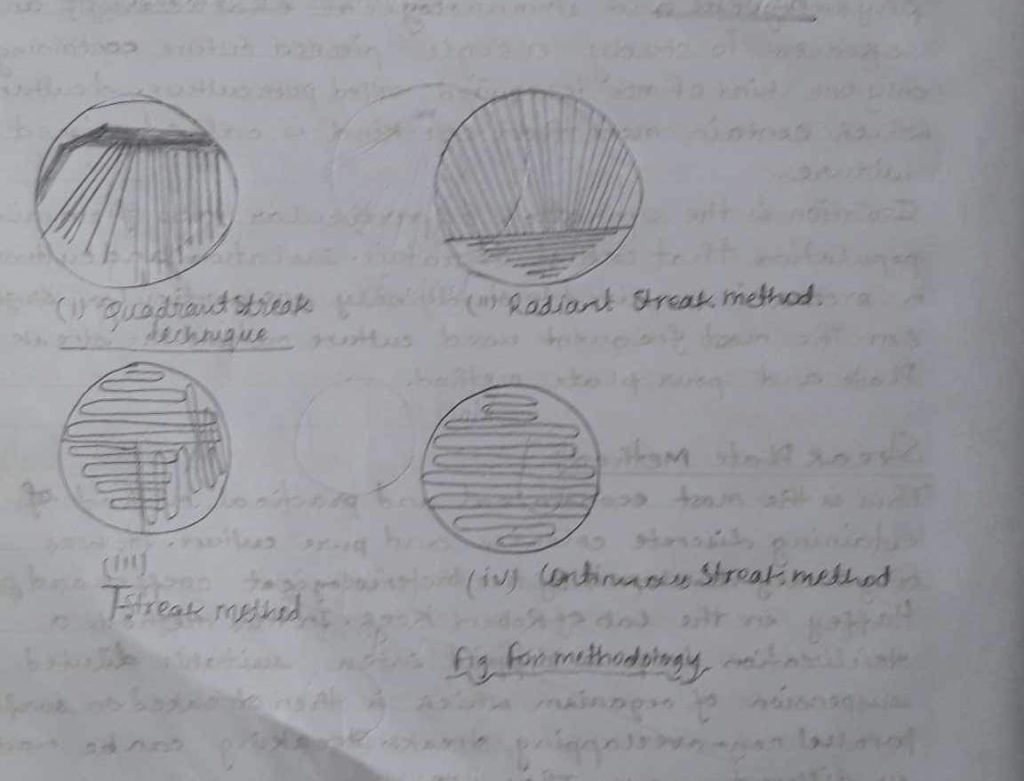Introduction:
Our environment is composed of many organisms in mixed ratio. It is very difficult to study morphology. Physiological and immunological characters of any species. To study a single piece a culture containing only one kind of mos is required called pure culture. A culture which contain more than one kind is called mixed culture.
Isolation is the separation of particular mos from mixed populations that exist in nature. Isolation and cultivation process is required to study only one particular organism. The most frequently used culture methods are streak Plate and pour plate method.
Streak Plate Method:
This is the most economical and practical method of obtaining discrete colonies and pure culture. It was originally developed by two bacteriological coeffeuard & Haffey in the lab of Robert Kock. In this method, a sterilization loop is dipped into a suitable diluted suspension of the organism which is then streaked on surface parallel non-overlapping streaks. Streaking can be made in different ways. They are:
i) Quadrant Streak
ii) Continuous Streak
iii) Radial Streak
iv) T-Streak

Materials Required:
i) Inoculating Loop
ii) Nutrient Agar
iii) Culture Broth
iv) Bacteriological Media
v) Suspension
vi) Bunsen Burner
Procedure:
i) The working table was disinfected with lysol.
ii) The plate was Labelled on the bottom with the name of the sample to be inoculated.
iii) Two burners were kept 10 cm apart on the left hand.
iv) Test tube containing the sample was held on the left hand.
v) The Loop was sterilized by the flame of the burner.
vi) Cotton plug of sample was removed.
vii) A loopful of suspension was taken from the test and the mouth of the tube was flamed.
viii) The petri plate cover was lifted with the left hand and was held at an angle of 60 degree.
ix) The plate was streaked by quadrant streak plate technique.
Quadrant streak Plate technique :
i) One loopful of organisms was spread over a small area near the edge of the plate and streaked it.
ii) The loopful was sterilized and was cooled.
iii) Five or six streaks were made from area 2 mm through area.
iv) The Loop was sterilized and cooled. By looking carefully many streaks were made from area and through area four and then the loop was sterilized.
v) The plate was incubated in an inverted position of 370C for 24 hours and then isolated Colonies were observed.
OBSERVATION TABLE:
| S.N | Media | Colour of colony | Site of colony | shape | margin | elevation | consistency | opacity |
| 1 | N.A | Yellowish white | 2mm | Circular | smooth | convex | soft | opaque |
| 2 | N.A | Light pink | 2mm | Round | smooth | convex | opaque |
Result:
Thus, by the streak plate method, isolated colonies of bacteria were grown.
Discussion:
In first area, Crowded colonies were seen and in 4th area no. of colonies were bigger more contamination were seen in nutrient agar in general purpose agar which grewal types of MOS.
Conclusion:
Hence, by streak plate method, isolated colonies of bacteria were grown in the lab and their characteris were studied.
Precaution:
i) During preparation culture, spreading colonies of bacteria should be done carefully, otherwise there may be growth of mos.
ii) The loop should be heated and cooled continuously during streaking.
Reference:
Shah. PK, Amatya J, Dohal – PR (2013) “Practical Microbiology” Revised edition, Detta offset Press, 64-68.
